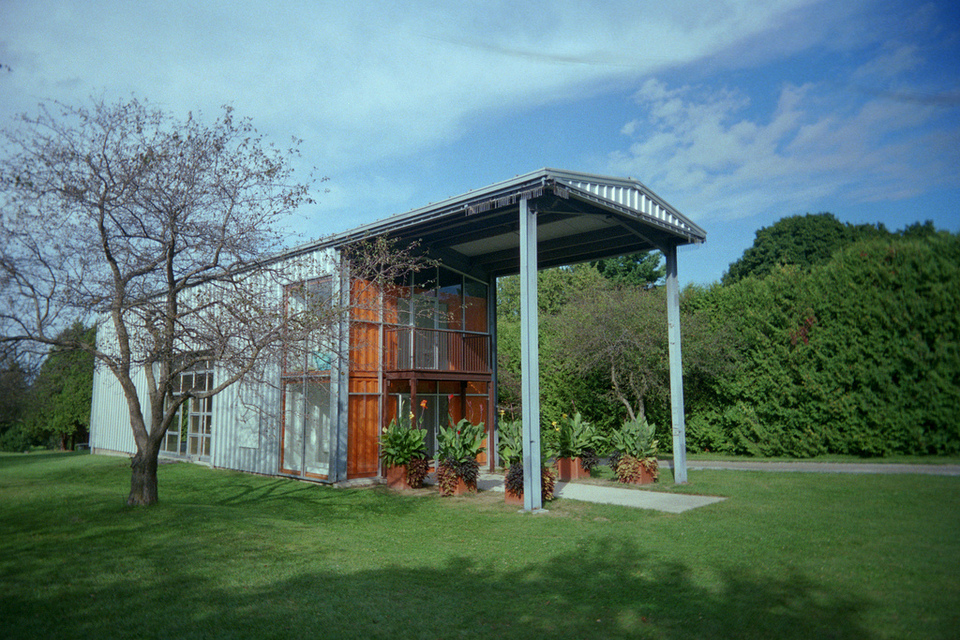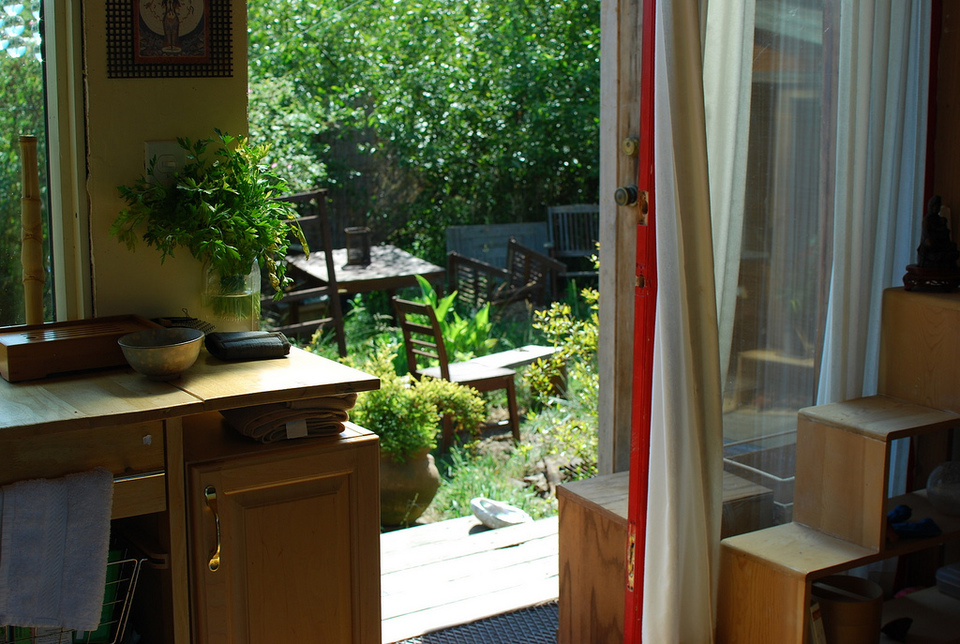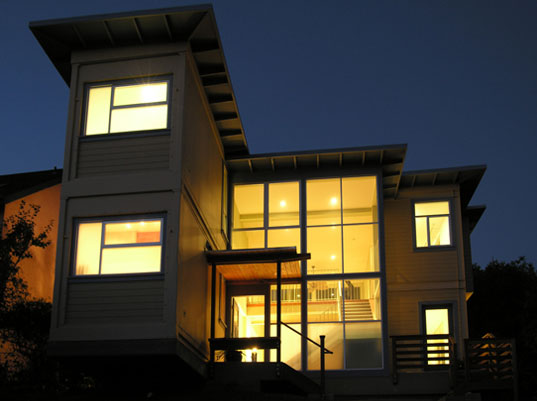Shipping containers started to travel around the globe in the 1960s, and cargo companies haven’t been able to replace them with any other means of goods transportation since then. They became the linchpin of global trade, carrying virtually any merchandise - from Chinese electronics and German cars to Canadian maple syrup.
The greatest strength of these containers is their durability. They're designed to survive the most horrifying storms while being transported on huge cargo ships across the ocean, along with the corrosion brought by salty water. The average life of a container is around 15 years. But when they're treated right, they're virtually indestructible by the elements.

Shipping container shops by Albert Freeman
Shipping containers aren't only strong, but they're also designed to interlock and stack on top of each other. This makes all sorts of impressive designs possible without us having to worry about the stability of our future dwelling. All this for a small fraction of the price you’d pay for a house built from regular materials!
Brad Tomecek, is the winner of the AIA National Young Architect Award and AIA Colorado Innovative Firm Award. We asked him how clients react when they're offered a solution that includes shipping containers:
We think of our container experience as a tool in our toolbox. We rarely push this type of construction on potential clients and, in fact, most clients ask us about this building method. We have always been interested in alternative construction methods. For the house in Nederland, Colorado, I was approached by the client who also happened to be a contractor. He was interested in recycling materials and using his house to start a dialogue with people about living smaller.
Shipping containers have been used as emergency and relief shelters around the world. State agencies often use them as units to provide for socially disadvantaged families, which are then moved after their purpose has been fulfilled. These basic units were developed by numerous construction companies and design studios to create pretty much anything - from luxury condos, vacation houses, and off-the-grid shelters to summer garden homes.

Shipping Container House by Angel Schatz
Benjamin is an architecture student at the University of Toronto. He's currently studying as an exchange student in Berlin, Germany. He shared his experience with this alternate building material:
Europeans are much more invested in alternative building designs. I drew a great inspiration from designs created by Belgian architects from Sculp(IT) and their four-room house where each of the four rooms serves a specific function in this shipping container home. Shipping containers have been around for so long, and yet we’ve only been incorporating them into our designs for very short time. I think they have a great future, especially in the cities like Beijing and Tokyo where overcrowding is becoming a significant problem.
Pick and Transport
You’d have to think two things through when planning to build a home using shipping containers. One is the reaction of the neighbourhood when you move in and start constructing your house out of used shipping containers. This tends to range from surprise to outrage. You also have to be very careful to comply with Toronto City Council and Committees' Regulations Applying to the Residential Zone Category and also with other by-laws and the municipal code.
Once you’ve overcome these minor obstacles, you have a huge variety of shipping containers to choose from. There are approximately 300,000 unused shipping containers just waiting to be bought and transformed into a house.

Shipping containers house by Alexander Raab
Prices of shipping containers may vary radically depending on the month you’re buying your mobile storage unit, the weather, or current market developments. Sustainable Sources' research showed that a basic 20 foot shipping container will, on average, cost about $1,500. This is the price of a container that's in average condition without any major visible defects. If you want to go for a refrigerated shipping container, you'll have to account for much higher expenses, often reaching around $4,500 for non-operating and from $6,000 to $7,500 for operating refrigeration systems.
Prices of 40 foot containers are usually more advantageous for a buyer when you consider the amount of space you’re getting. A basic undamaged 40 foot shipping container would set you back approximately $2,100 to $2,300. The ones that are usually more expensive are high cube (these are somewhat taller). A version with a non-operating refrigerator will cost you about $4,500, and one with a working refrigerating system will cost you between $7,500 and $9,500.
The transportation of your chosen shipping container isn't very difficult either. You should always try to look for shipping containers that are easily accessible. Especially when you buy a container from a shipyard, be very careful not to buy one that's at the bottom of a stack of another ten containers, otherwise you’ll have to pay for the shipyard crane services as well!
The cost of delivery varies depending on the size of the shipping container. Most containers are either 20 feet or 40 feet long. Twenty-foot containers can be delivered with a standard 20 foot roll-back tow truck. The fee you’d pay won’t exceed a normal towing fee. On the other hand, 40 foot containers would require a truck with a trailer to bring your baby home. The fee for this service usually amounts to three to four times more than the fee for a single tow truck, depending on the company you use.
The Price
Let’s say you’re a couple who decided to build a nice weekend house for yourselves in the countryside. It doesn’t need to be too big, since you’re a very sporty couple and you plan to spend most of the time hiking anyway. You’ve decided to buy two 40 foot shipping containers and you’ve already managed to have them transported to your property in, say, Northern Ontario, and you’ve filed all the paperwork with the local town hall.
It’s time to estimate the cost of turning these two 40 foot iron boxes into a living space. After you check the measurements of your containers once again, you should have a block that's 40 feet long, 16 feet wide, and 8.6 feet high (9.6 ft if it’s a high cube - for more measurements, check the specs section of this article). If you bought two regular 40 foot shipping containers, you now own a little less than 640 square feet of living space. Let’s see how much we have to invest in renovation works. You can easily create the checklist yourselves, but you should at least carry out these basic steps to turn your new shipping containers into a cozy weekend getaway. You need to first cut out doors and windows - finally a chance to try the craziest shapes you can think of without the need to create complicated structural plans as well. Secondly, you have to put in drywall, heating, and plumbing. If you don’t have time to acquire the expertise to actually do all these things yourself, a professional firm will do these works from $110 to $220 per square foot. So your weekend house would cost you anywhere from $74,500 to $143,300, depending on the state of the container when you bought it and the rates for the works you want from the firm you hire.

Shipping container house interior kitchen sofa and little library by Nicolas Boullosa
We've also asked Tomecek if he, as one of the most successful architects who's worked with shipping containers, plans an expansion on a Canadian market - and what his future projects will be:
We are first and foremost a custom architectural firm. We have done projects across the United States and currently have a few inquiries from Alberta. We have a hunting cabin finishing up in Canon City, Colorado, this winter. Next will be a 1,700 square foot hybrid project above Boulder, Colorado, overlooking the plains.
If you want to use shipping containers and you'd like to consult with or hire a firm to do the whole job, there are almost no limits for hiring a firm that will create a customized design for you. It's very common to hire a firm that isn't from the same province. People quite often go for a firm that fulfills their ideas best, even if it's from the other side of the world.
Toronto Shipping In
Toronto is one of the world’s most open-minded cities. Toronto values a culture of innovation and green solutions highly, so it comes as no surprise that some of the most successful companies working in the shipping container accommodation sector are based here.
There are two companies we feel compelled to mention. The first is MEKA, a company creating modular buildings worldwide that was born in Toronto. These prefabricated houses can be shipped anywhere around the world in mere weeks — sometimes even days. The range of buildings they offer ranges from their smallest studio ALP 320 with 320 square feet and a price tag of $72,000 when shipped ($85,500 with assembly foundation and roof) all the way up to the top-of-the line, three-bedrooms, three-bathroom, 1,920 square foot, three-storey family home JAM 1920.
The second pride of Toronto’s shipping container construction industry is a small company called Ecopods. Dwight Doerkson has developed a green building that’s transportable and doesn’t need to be hooked up to the any grid. The shipping container has an entire wall cut out and hung back on, so when you wish to leave your home or garden house or guest house, a solar-powered winch closes up the box. In summer, you can lower the wall, which creates a deck - ideal for sunbathing or just hanging out with friends. If it gets a bit chilly, you can simply get back inside and close the gap with sliding glass doors if you still want to keep the view. Ecopods start at about $40,000.

Shipping container house by Lorigami
The Projects
There's much more Toronto can offer when it comes to shipping container homes than the companies that make actual homes out of shipping containers. Some communities have taken the initiative and created various solutions, including this amazing way of building.
Toronto-based firm Levitt Goodman Architects is well known for its green designs. This firm partnered up with Evergreen, a non-profit with a mission of creating sustainable urban environments. Together, they developed the Evergreen Brick Works, the adaptive reuse of Toronto's former Don Valley Brick Works brickyard. The bright green Welcome Hut is made of none other than a recycled shipping container that creates kind of a gate into the whole area.
Last but not least is the Market 707 project, a bunch of shipping containers revamped into a market with lots of little shops and ten different kinds of international street food, plus coffee, bike shops, and much more. For a little over $10 a day, vendors can rent out the space and set up their business, giving young entrepreneurs a chance to develop a company. The project has livened up the neighbourhood and received very positive feedback from locals as well!
The Specs
A 20 foot shipping container is 19’10½” long, 8′ wide, and 8’6″ high on the outside. The internal measurements are smaller: 19’3″ long, 7’8″ wide, and 7’9⅞” high. Empty, it would weigh 5,050 pounds. The 20 foot shipping container with a refrigeration system typically has smaller internal measurements: 17’11″ long, 7’6″ wide, and 7’6″ high. Empty, it would weigh 6,503 pounds.
A 40 foot shipping container is 40’ long, 8′ wide, and 8’6″ high on the outside. The internal measurements are smaller: 39’5″ long, 7’8″ wide, and 7’9⅞” high. Empty, it would weigh 8,000 pounds. The 40 foot shipping container with a refrigeration system’s internal measurement are typically 37’11″ long, 7’6″ wide, and 7’6″ high. Empty, it would weigh 9,750 pounds.

Container city by Martin Deutch
MH00SK







